2009 Yamaha SuperJet Review
Yamaha's stand-up craft is made for racing
Equipped with a hull developed by a racing team, the new Yamaha SuperJet is made for racing whether in closed course, surf riding or freestyle.
When Yamaha introduced its new range of personal watercraft last summer, the company made a big deal about its new supercharged runabout (the FX SHO); however, it seemed that nobody had noticed that the SuperJet was given a major overhaul. While the engine remained the same, the SuperJet was equipped with a brand new hull that was originally designed and developed by Rius Racing.
Hull Characteristics
Rius Racing originally developed the new hull for the European GP Ski class. The hull features specially designed built-in front sponsons that increased the width of the front section. Additionally, the stern is narrower and the strakes are deeper. The pump was moved backwards 50mm and the ride plate length was increased in order to create a longer waterline length.
Additionally, Yamaha engineers enhanced rider ergonomics by putting in a shorter handle pole, which provides a lean-forward posture, ideal for racing use. The handle pole was also equipped with a harder spring that ensures less rider fatigue. The Hyper-Flow jet pump accommodates a new stainless steel impeller and an adjustable steering nozzle.
Race-Course Oriented
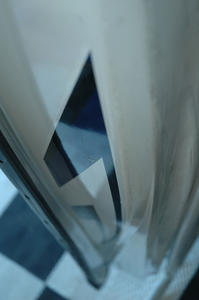 Note the new built-in front sponsons that come straight from Rius’s GP Ski.
Note the new built-in front sponsons that come straight from Rius’s GP Ski. 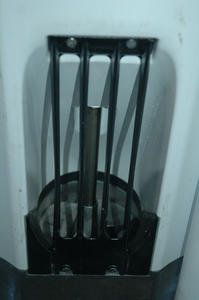 The intake shape has been altered in order to suck more water
The intake shape has been altered in order to suck more waterHaving ridden Rius’s carbon hull power valve engine SuperJet only four days prior to testing the new stock SuperJet gave me an idea of what I could expect to feel when I climbed aboard the Yamaha. The actual test was carried out on Lake Havasu in Arizona by using part of the official race course. World famous freestyle rider, Canadian Rick Roy, also demanded to ride the SuperJet, a will that Yamaha WaveRunner product manager Scott Watkins fulfilled since he has a great respect for the pioneer of the new Freestyle generation.
What surprised me most on the new, improved SuperJet was how it steered round the buoy. The 2009 SuperJet turns sharply and aggressively. The hull design enabled me to grade it in the curve rather than keep it flat on the water surface. The harder I was pushing it round the buoy the sharper it was turning. It was a unique feeling that no other SuperJet had given me in the past except the Rius Racing GP Ski.
Undoubtedly the team had done a great job. The steering was precise, accurate and less forgiving in comparison to its predecessor. The lightweight feel of the Yamaha has remained unchanged and the new riding position provids a better overall mass distribution. The new hull gave me a better feeling and enhanced information of how the hull was gripping, so when I was pushing it to its limits, it responded well by providing predictable handling. Also noticeable was the fact that there was less nose hopping at top speed in comparison to the previous model.
Having ridden Rius’s SuperJet just four days prior to riding Yamaha’s factory model, another thing that really stood out was the stock engine’s performance. There is no doubt that the Yamaha OEM engine needs some updating. It has been in the market successfully for 10 years, but the market demands have changed. Though it still provides good bottom end acceleration and linear power delivery from midrange, I believe that Yamaha could have improved the overall package with off the shelve parts. On the other hand, I was already informed that the Japanese department did not want to raise the overall cost of the particular model since the market demand is substantially lower in the stand-up class. For the time being the aftermarket will have to be relied upon for engine improvements.
Most WaveRunner fans were expecting Yamaha to launch a new 4-stroke stand up, though the Japanese firm kept the same recipe under the hood of the Super Jet. Scott Watkins assured me that Yamaha has been extensively testing 4-stroke packages for the SuperJet. Yamaha has tried single cylinder, two cylinder and even four cylinder options. Water is bound to get into the engine compartment no how much you try to avoid it and that gives Yamaha some concern about the 4-stroke project.
In the next few years 4-stroke Skis will rise to the market from the Japanese constructors, though they will make sure that these Skis have superb performance, excellent reliability, and, of course, warranty.
| 2009 Yamaha SuperJet Specs | |
| Engine Type | 2-Cylinder, 2-Stroke |
| Bore x Stroke | 81mm x 68mm |
| Displacement | 701cc |
| Fuel | Regular Unleaded |
| Type of Intake | Reed Valve |
| Type of Scavenging | Loop-Charged |
| Type of Exhaust | Wet |
| Type of Lubrication | Pre-Mixed Oil and Gas |
| Mixing Ratio | 50:1 |
| Cooling | Water |
| Starting | Electric |
| Ignition | Analog |
| Compression Ratio | 7.2:1 |
| Carburetor/Injection | (2) Mikuni Super BN 38 |
| Spark Advance | 6° |
| Ignition Timing | 15° BTDC – 21° BTDC |
| Spark Plug | NGK B7HS/BR7HS |
| Pump | 144mm Axial Flow |
| Transmission | Direct Drive From Engine |
| Impeller | 3-Blade, Aluminum (13/16 pitch) |
| Length x Width x Height | 88.2 in x 26.8 in x 26 in |
| Dry Weight | 291 lb |
| Fuel Capacity | 4.8 gal |
| Reserve Fuel Capacity | 1.45 gal |
| Vehicle Capacity | One person |
| Hull Material | SMC (Sheet Molded Compound) |
| Warranty | One-year limited warranty |
| Color | Atomic Blue |
| MSRP | $7,199 |
Get PersonalWatercraft.com in your Inbox!
Like PersonalWatercraft.com on Facebook
Comments
Most Popular

2025 Yamaha JetBlaster PRO 2-Up Review

2024 Kawasaki Jet Ski STX 160X Review

Remembering the Sea-Doo XP

Whatever Happened to the Wetbike?

2025 Yamaha JetBlaster Review




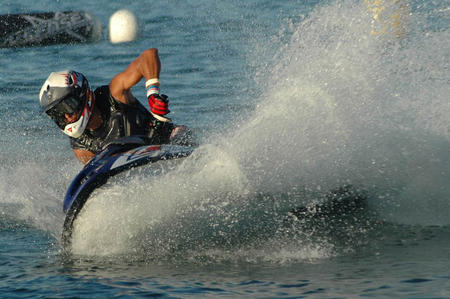
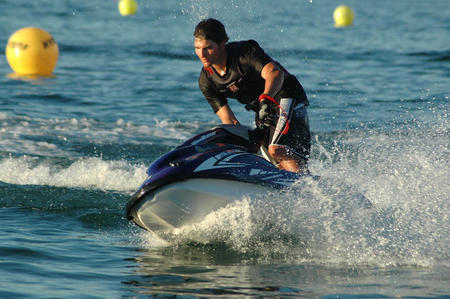
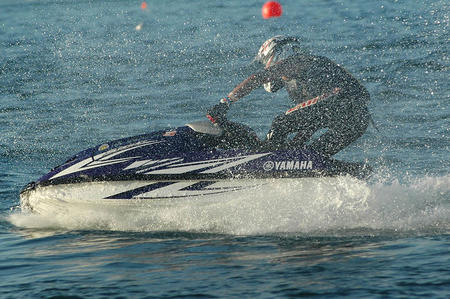
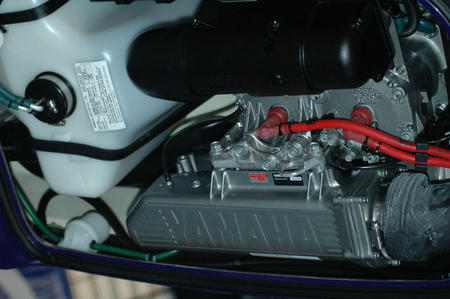









 Your Privacy Choices
Your Privacy Choices